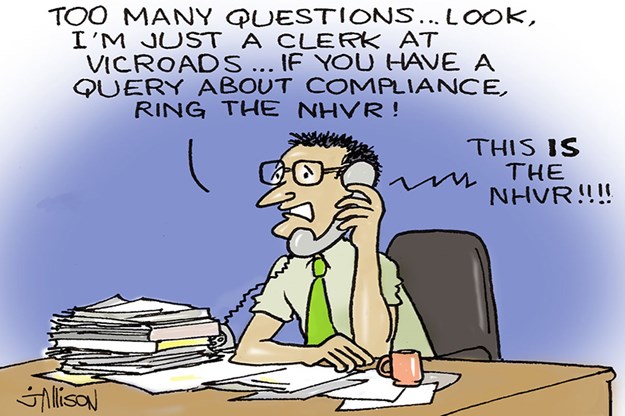OPINION: Outside state government acts, the Heavy Vehicle National Law has 759 sections, beyond the grasp of most truck drivers
As the country begins to emerge from the fog of COVID-19, or so we are told, it is an excellent time to reflect on just how truck drivers and operators are faring. It wasn’t that long ago when politicians bandied about terms like ‘essential service’ and ‘carrying the nation’.
I write this piece while suffering from a decent dose of the ‘Rona’ myself. I’ll think I’ll pull through but would not wish it upon anyone (I can have my own private thoughts, however). It is real, and we can only imagine the despair felt by truck drivers during the height of the pandemic. Having to endure tests every 72 hours and interpret ever-changing health directions and permits must have caused insufferable hardship to many. I could hardly stand giving myself a RAT test, let alone having a stranger poke what might seem like a telegraph pole up your nose every couple of days.
We handled quite a few of the fines dished out to truck drivers under what we would describe as unfair circumstances. Most got withdrawn after we got involved, although we had an extraordinary experience in the Western Australia jurisdiction.
A client had instructed us to court elect a penalty notice issued by WA Police. The driver had pulled up to refuel in Coolgardie and was doing so in the unattended truck section. Leaving his mask off and walking around to check things, WA Police swooped and issued a penalty notice exceeding $1,500. Some might say the driver was exercising, which was allowed without a mask. What was the public interest in issuing that fine?
My point in general terms is this. Everyone was suffering during the pandemic, yet many were prospering. The number of penalty notices and fines issued is staggering and truck drivers remained easy targets. Now that most if not all of the restrictions have been lifted, you could possibly think the transport industry may be able to recoup some of the losses suffered during the pandemic. However, it would seem not and all the prosecuting authorities around the country seem to have short memories.
Lack of discretion
A big take-out point for us is discretion or lack thereof. We often ask courts to apply discretion when it could have been applied at the intercept point. We often encounter court attendance notices with multiple sequences or counts. Police especially seem to relish going back through work diaries – in some cases over the years – and prosecuting every error they can detect.
RELATED ARTICLE: Drivers left holding the can
When we go to court, our written submissions talk about the principle of totality and the prohibition upon punishing multiple contraventions. We don’t believe that that was ever the intention of the Heavy Vehicle National Law (HVNL). However, what was intended and what we have today are two different creatures. The law remains to achieve its initial purpose. Check it out:
“The object of this Law is to establish a national scheme for facilitating and regulating the use of heavy vehicles on roads in a way that –
(a) promotes public safety; and
(b) manages the impact of heavy vehicles on the environment, road infrastructure and public amenity; and
(c) promotes industry productivity and efficiency in the road transport of goods and passengers by heavy vehicles; and
(d) encourages and promotes productive, efficient, innovative and safe business practices.”
I am sure many out there might have something to say about the above. As a legal practice that only deals with the HVNL and other road transport legislation related matters, we deal with some of the most technical and verbose legislation in force today. The ‘Plain English” method of legal drafting is nowhere to be found. The HVNL has 759 sections and four schedules alone.
Anyone who has attempted to interpret the Transport Operations (Road Use Management) Act in Queensland or the Road Safety Act in Victoria will know what I am talking about. It is extraordinarily complex legislation.
It is just another reason you need to speak to the team at Highway Advocates. We know what you need to know. Our continuing success speaks for itself and our policy of reversing the depersonalisation of our clients is resonating in the courts. We refuse to refer to our clients as “the accused” or “the defendant” unless it is essential. You are all real people with real hopes and aspirations.
Inciting fatigue
I’ll finish with one final point. Keeping in mind the object of the HVNL – promotes public safety.
A driver makes an error in their work diary, forgetting or getting confused about major rest breaks/concurrent and consecutive 24 hour periods, long/night hours … the list goes on. It goes straight to court with a critical fatigue breach, although there is no evidence of actual fatigue in most cases.
The prosecution will be chanting the maximum penalty in excess of $17,000 and four demerit points. Our response is to outline the actual reality of such fine. Most drivers before the court on this offence are paid by the kilometre. Many are not paid the award kilometre rate or other applicable allowances.
Any fine, let alone the maximum, will only cause that driver to work harder and longer to raise themselves out of the financial distress caused by the fine. Or, with the four demerit point hit, they may well decide to leave the industry altogether. Who will replace them, and how will that generally inexperienced replacement impact upon the promoting public safety message? Highway Advocates – we know what you need to know.
*ROBERT BELL, a former truck driver and current law undergraduate and practising paralegal, is the CEO and a director of Highway Advocates Pty Ltd. Contact Highway Advocates Pty Ltd on robert.bell@highwayadvocates.com.au
or phone 0488 010 101.




